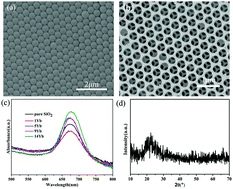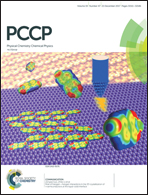Comprehensive investigations of near infrared downshift and upconversion luminescence mechanisms in Yb3+ single-doped and Er3+,Yb3+ co-doped SiO2 inverse opals
Abstract
Comprehensive investigations of near infrared (NIR) downshift and visible upconversion luminescence (UCL) mechanisms were carried out for Yb3+ single-doped and Er3+,Yb3+ co-doped SiO2 inverse opals under excitation at 256, 378, 520 and 980 nm. NIR emission at 976 nm from the Yb3+–O2− charge transfer state and UCL emission at 500 nm due to the cooperative emission of two Yb3+ ions were observed in SiO2:Yb3+ inverse opal upon excitation at 256 and 980 nm, respectively. The cooperative UCL of two Yb3+ ions was suppressed due to the photon trap created by the photonic band gap. For the SiO2:Er3+,Yb3+ inverse opals, NIR emission of Yb3+ at 976 nm and of Er3+ at 1534 nm were observed upon excitation at 256, 378 and 520 nm, respectively. Upon excitation at 378 and 520 nm, the 976 nm NIR emission of Yb3+ does not arise from (2H11/2/4S3/2) + 2Yb3+(2F7/2) → Er3+(4I15/2) + 2Yb3+(2F5/2) traditional quantum cutting. The NIR emission of Yb3+ at 976 nm may be due to the Er3+(2H11/2) + Yb3+(2F7/2) → Yb3+(2F5/2) + Er3+(4I11/2) cross-relaxation energy transfer process upon excitation at 520 nm. The NIR emission of Yb3+ at 976 nm may arise from the cross-relaxation energy transfer of Er3+(4G11/2) + Yb3+(2F7/2) → Yb3+(2F5/2) + Er3+(4F9/2) and Er3+(4F9/2) + Yb3+(2F7/2) → Yb3+(2F5/2) + Er3+(4I13/2) upon excitation at 378 nm.



 Please wait while we load your content...
Please wait while we load your content...